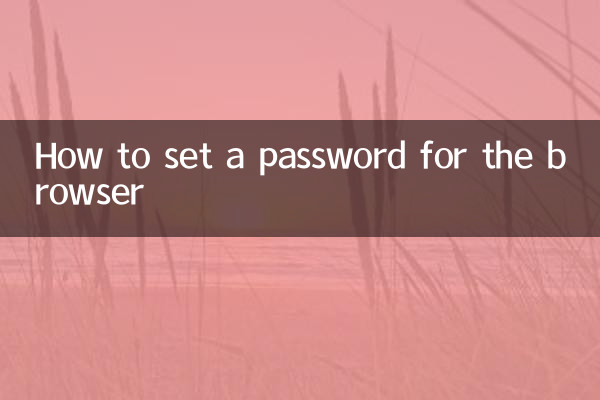Title: How to set a password for your browser
In today's digital era, a large amount of sensitive information is stored in browsers, such as account passwords, payment information, etc. In order to protect privacy and security, setting a password for the browser has become a need for many users. This article will introduce in detail how to set passwords for different browsers, and provide hot topics and hot content across the Internet in the past 10 days as a reference.
1. Hot topics and hot content on the entire network in the past 10 days

| Date | hot topics | Hot content |
|---|---|---|
| 2023-11-01 | AI technology development | OpenAI releases new model, triggering heated discussion in the industry |
| 2023-11-03 | network security | Multiple data breaches around the world have drawn attention |
| 2023-11-05 | Browser security | Chrome’s new security features exposed |
| 2023-11-07 | Privacy protection | EU new privacy protection regulations introduced |
| 2023-11-09 | Technology products | Multiple new mobile phones released, with enthusiastic market response |
2. Why do you need to set a password for your browser?
1.protect privacy: Prevent others from viewing browsing history and personal information at will.
2.Prevent data leakage: Prevent sensitive information such as account passwords from being stolen.
3.Home Sharing Devices: Keep personal data safe when sharing computers.
4.work safety: Prevent colleagues or others from viewing sensitive work-related information.
3. How to set passwords in mainstream browsers
| Browser | Setting method | Things to note |
|---|---|---|
| Google Chrome | Set passwords via extensions such as "LockPW" | Need to download from official app store |
| Microsoft Edge | Use Windows account password protection | Requires Microsoft account login |
| Mozilla Firefox | Protect saved passwords with the Master Password feature | Does not protect the entire browser |
| Safari | Use your Mac system password or Touch ID | Mac devices only |
| Opera | Set password via third-party extension | More limited functionality |
4. Detailed setting steps (taking Chrome as an example)
1.Install extension: Open the Chrome App Store and search for "LockPW" or similar password protection extensions.
2.Set password: After installation, follow the prompts to set the master password.
3.Configuration options: You can choose to lock the entire browser or specific features.
4.test function: Close the browser and reopen it to check whether the password protection is effective.
5.Regularly updated: Keep extensions up to date for security.
5. Other suggestions for protecting browser security
1.Clean cache regularly: Avoid long-term storage of sensitive information locally.
2.Use privacy mode: Turn on stealth mode when handling sensitive information.
3.Enable two-step verification: Add an extra layer of protection to important accounts.
4.Update browser: Install security patches and updates promptly.
5.Use a password manager: Professional tools are more secure than the browser's own password storage.
6. Frequently Asked Questions
| question | answer |
|---|---|
| What should I do if I forget my browser password? | This can be solved through the password reset function of the extension or uninstalling and reinstalling. |
| Will password protection affect browsing speed? | Basically not, modern extensions are well optimized |
| Will it affect the autofill function? | Depending on the specific setup, this usually works fine |
| Can I set a password on my mobile browser? | Some browsers support it, or you can use the device lock screen password |
7. Summary
Setting a password for your browser is an important measure to protect personal privacy and data security. Although different browsers have different settings, a certain level of protection can be achieved through extensions or system functions. Combined with other security measures, such as regularly clearing caches and using a password manager, you can build a more comprehensive defense. Today, as Internet information becomes increasingly important, it is important for everyone to develop good browser usage habits.
As network security issues become increasingly prominent, browser password protection may become standard in the future. At present, users still need to take proactive measures to choose a protection method that suits them to ensure that their personal information is safe and worry-free.

check the details

check the details